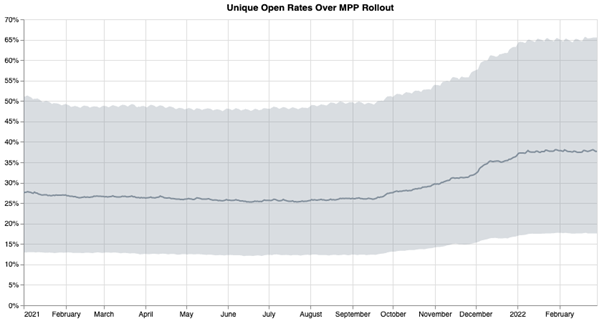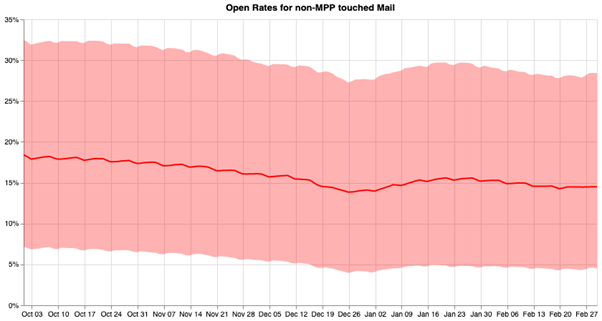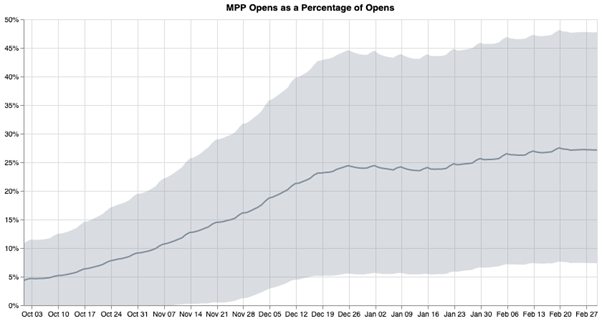Are Opens Really Dead?
Now that we’re almost a half-year into the rollout of iOS 15 and Apple’s Mail Privacy Protection (MPP) – which protects user privacy by proactively loading all the images in users emails so as to reduce the utility of these pixels for tracking users and user activity – it seems like a good time to check in on the performance impacts of these changes on email sending and open rates.
When we look at overall unique email open rates, we see a consistent increase by about 12% gross percentage points for most senders, with three quarters of customers seeing at least an 8% lift and one quarter seeing 15% or more. These are material numbers for senders and not something that can simply be ignored.

So, what can you do about it?
For senders that have good response rates with clicks (or better yet, attributable conversions), simply switching to those data points is one possible way to proceed. But not every program does that. Are opens simply dead? Not yet.
While the open as a metric for measuring individual behavior or as a trigger in a workflow is now unsafe, as an aggregate take on group behavior, it remains relevant and useful. One technique is to remove all MPP opens from the data you’re measuring. Discard MPP opens from the numerator and remove deliveries that resulted in MPP opens from the denominator. You end up with a different rate, but one which is much more stable over time. Here’s how that looks since the rollout of MPP started:

We do see a slight decline here over the measurement period (likely due to excluding so many active mobile users), but overall it is much more consistent and thus makes it a better metric to use as an indicator of positive or negative change.
As MPP adoption has leveled off, we see just over a quarter of opens overall coming from MPP on average, and for three quarters of senders it’s less than 50%. While these huge numbers explain why individual opens are no longer safe to trust, it also means that a majority of your open data is still as useful as it was before – more than enough to use for the purpose of aggregate stats.

So this leaves us with the reports of the death of opens being exaggerated, though if we have additional large providers (specifically Gmail or VMG) move to pervasive pre-fetching, that should cause a reevaluation of things.

Photo by Viktor Forgacs on Unsplash

 How to resolve AdBlock issue?
How to resolve AdBlock issue? 
 George Schlossnagle is a Co-Founder, Distinguised Engineer, and a Member of the Board at SparkPost (recently acquired by MessageBird). George has been working in email since 1999, when he and his brother began developing what would become the Momentum mail transfer-agent at OmniTI. Following the spin-out of SparkPost from OmniTI in 2008, George held the roles of CEO and CTO before moving into his current role in 2020. Through the expansive Momentum on-premises footprint and his role moving SparkPost into the cloud, George has overseen the evolution of enterprise-grade email sending and analytics over the past two decades.
George Schlossnagle is a Co-Founder, Distinguised Engineer, and a Member of the Board at SparkPost (recently acquired by MessageBird). George has been working in email since 1999, when he and his brother began developing what would become the Momentum mail transfer-agent at OmniTI. Following the spin-out of SparkPost from OmniTI in 2008, George held the roles of CEO and CTO before moving into his current role in 2020. Through the expansive Momentum on-premises footprint and his role moving SparkPost into the cloud, George has overseen the evolution of enterprise-grade email sending and analytics over the past two decades.